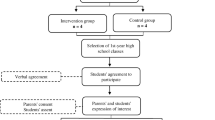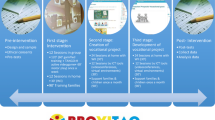Abstract
During childhood and adolescence, a game could be an effective educational tool to learn healthy eating habits. We developed Kaledo, a new board game, to promote nutrition education and to improve dietary behavior. A two-group design with one pre-treatment assessment and two post-treatment assessments was employed. A total of 3,110 subjects (9–19 years old) from 20 schools in Campania, Italy, were included in the trial. In the treated group, the game was introduced each week over 20 consecutive weeks. Control group did not receive any intervention. The primary outcomes were (i) score on the “Adolescent Food Habits Checklist” (AFHC), (ii) scores on a dietary questionnaire, and (iii) BMI z-score. At the first post-assessment (6 months), the treated group obtained significantly higher scores than the control group on the AFHC (14.4 (95 % confidence interval (CI) 14.0 to 14.8) vs 10.9 (95 % CI 10.6 to −11.2); F(1,20) = 72.677; p < 0.001) and on four sections of the dietary questionnaire: “nutrition knowledge” (6.5 (6.4 to 6.6) vs 4.6 (4.5 to 4.7); F(1,16) = 78.763; p < 0.001), “healthy and unhealthy diet and food” (11.2 (11.0 to 11.4) vs 10.4 (10.3 to 10.6); F(1,32) = 21.324; p < 0.001), “food habits” (32.4 (32.0 to 32.8) vs 27.64 (27.3 to 28.0); F(1,26) = 195.039; p < 0.001), and “physical activity” (13.4 (13.2 to 13.7) vs 12.0 (11.8 to 12.6); F(1,20) = 20.765; p < 0.001). Moreover, the treated group had significantly lower BMI z-score with respect to the controls at the first (0.44 (0.42 to 0.46) vs 0.58 (0.56 to 0.59), F(1,18) = 16.584, p = 0.001) and at the second (18 months) (0.34 (0.30 to 0.38) vs 0.58 (0.54 to 0.62), F(1,13) = 7.577; p = 0.017) post-assessments. Conclusion: Kaledo improved nutrition knowledge and dietary behavior over 6 months and had a sustained effect on the BMI z-score. Therefore, it may be used as an effective tool in childhood and adolescence obesity prevention programs.


Similar content being viewed by others
References
Amaro S, Viggiano A, Costanzo A, Madeo I, Viggiano A, Baccari ME, Marchitelli E, Raia M, Viggiano E, Deepak S, Monda M, Luca B (2006) Kalèdo, a new educational board-game, gives nutritional rudiments and encourages healthy eating in children: a pilot cluster randomized trial. Eur J Pediatr 165:630–635. doi:10.1007/s00431-006-0153-9
Baranowski T, Baranowski J, Cullen KW, Marsh T, Islam N, Zakeri I, Honess-Morreale L, deMoor C (2003) Squire’s Quest! Dietary outcome evaluation of a multimedia game. Am J Prev Med 24:52–61
Bartfay WJ, Bartfay E (1994) Promoting health in schools through a board game. West J Nurs Res 16:438–446. doi:10.1177/019394599401600408
Baur LA, Hazelton B, Shrewsbury VA (2011) Assessment and management of obesity in childhood and adolescence. Nat Rev Gastroenterol Hepatol 8:635–645. doi:10.1038/nrgastro.2011.165
Binkin N, Fontana G, Lamberti A, Cattaneo C, Baglio G, Perra A, Spinelli A (2010) A national survey of the prevalence of childhood overweight and obesity in Italy. Obes Rev 11:2–10. doi:10.1111/j.1467-789X.2009.00650.x
Biro FM, Huang B, Morrison JA, Horn PS, Daniels SR (2010) BMI, BMI indices, and waist-to-height changes during teen years in girls are influenced by childhood BMI. J Adolesc Health 46:245–250. doi:10.1016/j.jadohealth.2009.06.023
Blakely G, Skirton H, Cooper S, Allum P, Nelmes P (2009) Educational gaming in the health sciences: systematic review. J Adv Nurs 65:259–269
Bonati M, Campi R (2005) What can we do to improve child health in southern Italy? PLoS Med 2:e250. doi:10.1371/journal.pmed.0020250
Cacciari E, Milani S, Balsamo A, Dammacco F, De Luca F, Chiarelli F, Pasquino AM, Tonini G, Vanelli M (2002) Italian cross-sectional growth charts for height, weight and BMI (6-20 y). Eur J Clin Nutr 56:171–180. doi:10.1038/sj.ejcn.1601314
Cole TJ, Bellizzi MC, Flegal KM, Dietz WH (2000) Establishing a standard definition for child overweight and obesity worldwide: international survey. BMJ 320:1240
Cole TJ, Faith MS, Pietrobelli A, Heo M (2005) What is the best measure of adiposity change in growing children: BMI, BMI %, BMI z-score or BMI centile? Eur J Clin Nutr 59:419–425. doi:10.1038/sj.ejcn.1602090
Committee on School Health (2004) Soft drinks in schools. Pediatrics 113:152–154
Contento I, Balch G, Bronner Y, Lytle L, Maloney S, Olson C (1995) Special issue—the effectiveness of nutrition education and implications for nutrition education policy, programs and research: a review of research. J Nutr Educ 27:277–422
Contento IR, Randell JS, Basch CE (2002) Review and analysis of evaluation measures used in nutrition education intervention research. J Nutr Educ Behav 34:2–25
Cullen KW, Watson K, Baranowski T, Baranowski JH, Zakeri I (2005) Squire’s Quest: intervention changes occurred at lunch and snack meals. Appetite 45:148–151
Flodmark C-E, Marcus C, Britton M (2006) Interventions to prevent obesity in children and adolescents: a systematic literature review. Int J Obes (Lond) 30:579–589. doi:10.1038/sj.ijo.0803290
Freedman DS, Mei Z, Srinivasan SR, Berenson GS, Dietz WH (2007) Cardiovascular risk factors and excess adiposity among overweight children and adolescents: the Bogalusa Heart Study. J Pediatr 150:12–17
Gillis L (2003) Use of an interactive game to increase food acceptance—a pilot study. Child Care Health Dev 29:373–375
Johnson F, Wardle J, Griffith I (2002) The adolescent food habits checklist: reliability and validity of a measure of healthy eating behaviour in adolescents. Eur J Clin Nutr 56:644–649
Johnson-Taylor WL, Everhart JE (2006) Modifiable environmental and behavioral determinants of overweight among children and adolescents: report of a workshop. Obesity 14:929–966. doi:10.1038/oby.2006.109
Lakshman RR, Sharp SJ, Ong KK, Forouhi NG (2010) A novel school-based intervention to improve nutrition knowledge in children: cluster randomised controlled trial. BMC Public Health 10:123. doi:10.1186/1471-2458-10-123
Micciolo R, Di Francesco V, Fantin F, Canal L, Harris TB, Bosello O, Zamboni M (2010) Prevalence of overweight and obesity in Italy (2001-2008): is there a rising obesity epidemic? Ann Epidemiol 20:258–264. doi:10.1016/j.annepidem.2010.01.006
Murray DM (2001) Statistical models appropriate for designs often used in group-randomized trials. Stat Med 20:1373–1385
Murray DM, Hannan PJ, Wolfinger RD, Baker WL, Dwyer JH (1998) Analysis of data from group-randomized trials with repeat observations on the same groups. Stat Med 17:1581–1600
Naser KA, Gruber A, Thomson GA (2006) The emerging pandemic of obesity and diabetes: are we doing enough to prevent a disaster? Int J Clin Pract 60:1093–1097. doi:10.1111/j.1742-1241.2006.01003.x
Prentice AM (2006) The emerging epidemic of obesity in developing countries. Int J Epidemiol 35:93–99. doi:10.1093/ije/dyi272
Siervogel RM, Demerath EW, Schubert C, Remsberg KE, Chumlea WC, Sun S, Czerwinski SA, Towne B (2003) Puberty and body composition. Horm Res 60:36–45. doi:10.1159/000071224
Silveira JA, Taddei JA, Guerra PH, Nobre MR (2013) The effect of participation in school-based nutrition education interventions on body mass index: a meta-analysis of randomized controlled community trials. Prev Med 56:237–243. doi:10.1016/j.ypmed.2013.01.011
Singh AS, Mulder C, Twisk JWR, Van Mechelen W, Chinapaw MJM (2008) Tracking of childhood overweight into adulthood: a systematic review of the literature. Obes Rev 9:474–488. doi:10.1111/j.1467-789X.2008.00475.x
Summerbell CD, Waters E, Edmunds LD, Kelly S, Brown T, Campbell KJ (2005) Interventions for preventing obesity in children. Cochrane Database Syst Rev CD001871. doi:10.1002/14651858.CD001871.pub2
Turconi G, Celsa M, Rezzani C, Biino G, Sartirana MA, Roggi C (2003) Reliability of a dietary questionnaire on food habits, eating behaviour and nutritional knowledge of adolescents. Eur J Clin Nutr 57:753–763. doi:10.1038/sj.ejcn.1601607
Turnin MC, Tauber MT, Couvaras O, Jouret B, Bolzonella C, Bourgeois O, Buisson JC, Fabre D, Cance-Rouzaud A, Tauber JP, Hanaire-Broutin H (2001) Evaluation of microcomputer nutritional teaching games in 1,876 children at school. Diabetes Metab 27:459–464
Waters E, de Silva-Sanigorski A, Hall BJ, Brown T, Campbell KJ, Gao Y, Armstrong R, Prosser L, Summerbell CD (2011) Interventions for preventing obesity in children. Cochrane Database Syst Rev CD001871. doi:10.1002/14651858.CD001871.pub3
Zheng W, Suzuki K, Sato M, Yokomichi H, Shinohara R, Yamagata Z (2014) Adolescent growth in overweight and non-overweight children in Japan: a multilevel analysis. Paediatr Perinat Epidemiol 28:263–269. doi:10.1111/ppe.12116
(2010) Italian National Survey “OKkio alla SALUTE.” http://www.epicentro.iss.it/okkioallasalute/ReportRegionali2010.asp. Accessed 20 Mar 2012
Acknowledgments
Kaledo was patented by Bruno De Luca and Salvatore Amaro as members of the non-profit organization Associazione Culturale Kaledo. At present, this national patent has expired.
Authors have no conflict of interest to declare. This research was funded by Second University of Naples, Associazione Culturale Kaledo, Regione Campania (Assessorato all’Istruzione), Provincia di Napoli, Provincia di Salerno Assessorato allo Sport, Comune di Cercola (Assessorato all’istruzione) and Fondazione per l’Assistenza all’Infanzia.
The authors would like to thank the school principals and the teachers of the schools Bordiga I (Naples), Matilde Serao (Volla-NA), Giovanni Falcone (Volla-NA), Caravita (Cercola-NA), S. Alfonso (Pagani-SA), Eduardo De Filippo (Sant’Egidio del Monte-SA), A. Genovesi (Nocera Inferiore-SA), SMS Marconi (S. Giorgio a Cremano-NA), Bordiga III (Naples), Antonio Custra (Cercola-NA), SMS Aniello Criscuolo (Pagani-SA), Quasimodo (Salerno), IPIA (Naples), Istituto Agrario De Cillis (Naples), Liceo Scientifico Portici (Portici-NA), ITIS Marconi (Nocera Inferiore-SA), ITIS San Giorgio (S. Giorgio a Cremano-NA), ITIS Galilei (Nocera Inferiore-SA), and Liceo Regina Margherita (Salerno) for their collaboration and free participation in the research. We also thank the editor and the anonymous reviewers for their constructive comments, which helped us to improve the manuscript. Finally, we would like to thank Fr. Salvatore Coppola who coined the word Kaledo from the ancient Greek words χαλως εδω (eating well).
Author information
Authors and Affiliations
Corresponding author
Additional information
Communicated by David Nadal
Rights and permissions
About this article
Cite this article
Viggiano, A., Viggiano, E., Di Costanzo, A. et al. Kaledo, a board game for nutrition education of children and adolescents at school: cluster randomized controlled trial of healthy lifestyle promotion. Eur J Pediatr 174, 217–228 (2015). https://doi.org/10.1007/s00431-014-2381-8
Received:
Revised:
Accepted:
Published:
Issue Date:
DOI: https://doi.org/10.1007/s00431-014-2381-8




